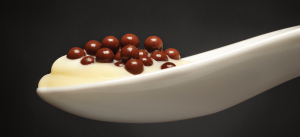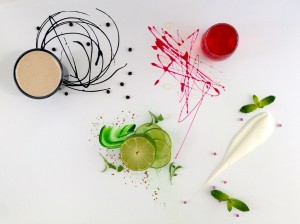Luckily, teaching them about how different ingredients become green and slimy, or not, doesn’t mean making a huge mess of inedible goo. Instead, it could mean making clear pea ravioli, edible lipstick, smoky ice cream or chocolate caviar — new food concepts that come from molecular gastronomy, a practice that puts a microscope over the cooking process. For chefs, this scientific approach to food means complete control over any recipe and consistent results with a creative component. For kids, molecular cooking is a chance to discover creative cooking early in life, to explore new foods and complement lessons from the classroom.
 By basic definition, molecular gastronomy is the subdiscipline of food science that looks at chemical and physical changes of individual ingredients and blends of ingredients that happen when we cook. For modernist chefs and anyone learning at home, it’s about deconstructing food to its most basic elements to restructure them into something less familiar. Take, for example, recipes by Molecule-R, a brand that makes molecular gastronomy kits and provides some quirky ingredients. It offers instructions on its website for deconstructed cocoa, which involves creating caviar-like spheres of chocolate. The instructions might be a little alien for most people: “In a rectangular, flat-bottomed bowl and using a hand blender, dissolve 1 sachet of SODIUM ALGINATE in the cocoa preparation. Let sit for 10 minutes.” Then it calls for a sachet of calcium lactate and holding a pipette at a 90 degree angle to function like a dropper, which gives shape to the caviar. A little chemistry know-how is required to understand how to whip up a saffron crème anglaise with coffee air or cook up foie hazelnuts. Still, kids can learn it alongside their teachers and parents.
By basic definition, molecular gastronomy is the subdiscipline of food science that looks at chemical and physical changes of individual ingredients and blends of ingredients that happen when we cook. For modernist chefs and anyone learning at home, it’s about deconstructing food to its most basic elements to restructure them into something less familiar. Take, for example, recipes by Molecule-R, a brand that makes molecular gastronomy kits and provides some quirky ingredients. It offers instructions on its website for deconstructed cocoa, which involves creating caviar-like spheres of chocolate. The instructions might be a little alien for most people: “In a rectangular, flat-bottomed bowl and using a hand blender, dissolve 1 sachet of SODIUM ALGINATE in the cocoa preparation. Let sit for 10 minutes.” Then it calls for a sachet of calcium lactate and holding a pipette at a 90 degree angle to function like a dropper, which gives shape to the caviar. A little chemistry know-how is required to understand how to whip up a saffron crème anglaise with coffee air or cook up foie hazelnuts. Still, kids can learn it alongside their teachers and parents.
 Chef Jozef Youssef, Founder of Kitchen Theory and Associate Editor at The International Journal of Gastronomy and Food Science, said he uses Molecule-R kits by MMTUM in his research with kids in his work with Oxford University’s Crossmodal Research Laboratory. “These days, there are loads of molecular kits you can buy out there meant for home users that will give you all the hydrocolloids, the gelling agents you need,” he said. “They’ll give you a little syringe and pipes and stuff like that.” For other options, Modernist Pantry offers slightly different kits from Molecule-R. Most molecular gastronomy kits cost less than $50, so it’s not a pricey endeavor. Youssef also recommended that anyone who wants to try molecular cooking pick up a small, inexpensive gold scale, for precise measurements.
Chef Jozef Youssef, Founder of Kitchen Theory and Associate Editor at The International Journal of Gastronomy and Food Science, said he uses Molecule-R kits by MMTUM in his research with kids in his work with Oxford University’s Crossmodal Research Laboratory. “These days, there are loads of molecular kits you can buy out there meant for home users that will give you all the hydrocolloids, the gelling agents you need,” he said. “They’ll give you a little syringe and pipes and stuff like that.” For other options, Modernist Pantry offers slightly different kits from Molecule-R. Most molecular gastronomy kits cost less than $50, so it’s not a pricey endeavor. Youssef also recommended that anyone who wants to try molecular cooking pick up a small, inexpensive gold scale, for precise measurements.
Youssef said his current research looks at how teaching kids about food, letting them handle different fruits and vegetables, and then giving them hands-on culinary play gives them access to more knowledge, enables them to make healthier choices and reduces the neophobia that can make it hard for kids to try new foods. “I think any form of playing with kids with food, whether it’s baking cookies or these molecular spheres or airs or foams, any interest shown by kids in the cooking process is really important,” Youssef said. “To some degree, we’ve implemented this into the culinary play we’re doing with the kids. We’ve got them doing some fun bits that are related to molecular cooking because they’ll find it fun and enjoyable.”
Educators have also taken note, and provided free lesson plans for teachers to use in the classroom. The European journal, Science in School, offers instructions on its website on how to form alginate bubbles and luminescent bubbles, designed by researchers from the University of Bremen’s chemistry education research group. The picture instructions look more like an experiment than a cooking class — though plenty of cooking classes are available through Kitchen Theory and Sur La Table, though ChefSteps and other web resources offer online classes and guides.
Molecular gastronomy gave rise to several techniques used in modern and everyday culinary applications, though it’s not always recognized as such. “Boiling an egg is molecular gastronomy if you want to look at it that way,” said Youssef. “It’s molecular gastronomy once you start taking note of the temperature and time, start focusing in on those details. You take a bit more of a studied or scientific approach toward your cooking.” Powdered food, for instance, is something that chefs can pair with olive oil and invent entirely new baking powders. Maltodextrin can turn high-fat liquids into powders, too. Sous vide, a method of cooking that involves vacuum-sealing food and submersing it in water at an exact temperature, is a molecular gastronomy technique Youssef uses to cook duck to exact specifications. “Yes, you could roast a duck in a pan and then shove it in the oven for a while, but you’ll get an inconsistent result,” he said. “When I cook my duck at 57 degrees [Celsius] for an hour and 20 minutes, I get exactly the same result each and every time. Is that crazy science? No, it’s basic science, but it’s guaranteeing me a consistent result in quality and flavor and taste I’m looking for.”
Though recipes involving timing and temperature have been around for longer than Marie-Antoine Carême’s instructions for broth, molecular gastronomy didn’t get its name until 1992, in a cooking workshop series called Science and Gastronomy. Hungarian Physicist Nicholas Kurti and French Physical Chemist Hervé This, who taught such workshops, are known for popularizing the concept, beginning in 1969, out of concern that humanity had more knowledge about space than it did about its own food. Kurti said, “I think it is a sad reflection on our civilization that while we can and do measure the temperature in the atmosphere of Venus, we do not know what goes on inside our soufflés.”
Source: http://www.kitchenwarenews.com/category/tools-gadgets/



